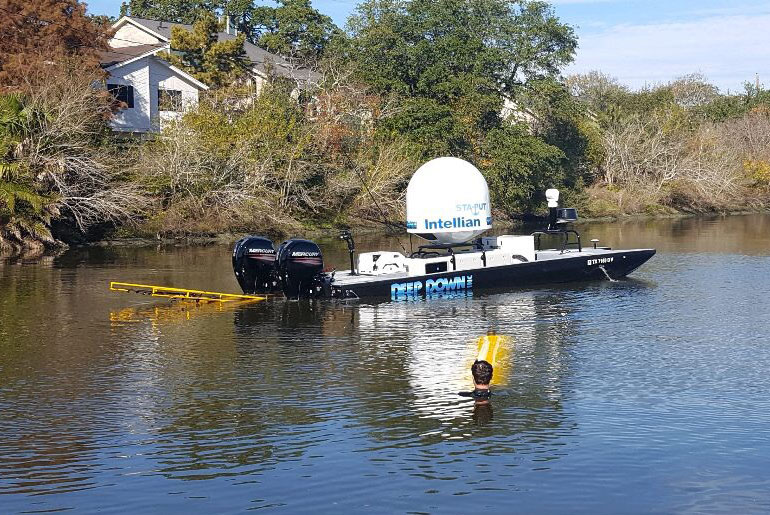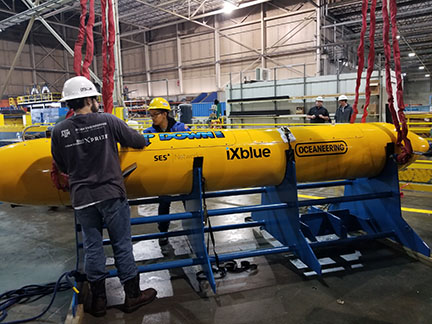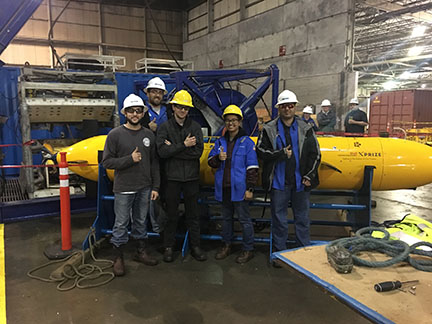
Aggie Ocean Discovery, a team of students from the College of Engineering at Texas A&M University, entered the Shell Ocean Discovery XPRIZE competition a mere three years ago. They have now been named a finalist in the global competition challenging teams to push the boundaries of ocean technologies.
The XPRIZE® has a reputation of presenting impossible challenges that inspire new industries and new ideas. The finalists will take 3-D scans of a 500-kilometer patch of ocean floor at a depth of 4,000 meters (almost 2.5 miles).
"As a society, we are entering a technological revolution, to be successful and keep ahead of the constantly changing climate, it requires a collaborative effort from the most innovative partners in their respective industries," said Dylan Blakeslee, a senior in the Department of Ocean Engineering. "The Shell XPRIZE pushes the students and their partners to look ahead and develop next generation technology. Having partners as passionate and innovative as Deep Down Inc. has allowed us to create technology incomparable with anything on the market today, without the industry support that we have been afforded, this wouldn't be possible."
The final part of the competition will take place at an undisclosed location to protect the integrity of the judging area. The Aggie team will be competing against nine other teams as finalists toward the end of 2018.
"When I first looked into the competition, I was specifically interested in the fact that it was a challenge to map the ocean floor," Blakeslee said. "Only five percent of the ocean has been mapped, yet it feeds a billion people and provides 50 percent of our oxygen. We have mapped land mass via satellite but have yet to come up with a viable solution to map the ocean floor and find what lays at the deepest depths of our oceans."
After deciding to accept the competition's challenge, Blakeslee turned to Dr. Sharath Girimaji, department head in the Department of Ocean Engineering at Texas A&M.
"The first meeting ended with Dr. Girimaji expressing concerns over the entry fee and an endless list of questions," Blakeslee said. "The following day, I returned with a pamphlet and 100 pages of documents I made to address his questions and Dr. Girimaji said, 'Okay, you have me convinced.'" The next step of the process was to motivate peers in all disciplines to join the effort and take time out of their already busy schedules to dedicate themselves completely to this project.
The next step of the process was to motivate peers in all disciplines to join the effort and take time out of their already busy schedules to dedicate themselves completely to this project.
The Texas A&M team has a torpedo-like autonomous underwater vehicle (AUV) called Marlin that will endure crushing pressure, utter darkness and will navigate autonomously without human intervention. Marlin will send data to its counterpart, a remote surface vessel (RSV) called Wahoo that in turn will send the data back to the control center on land where the data will be received and analyzed.
Marlin carries an on-board intelligence system, a long-range optical and acoustic communication and reference system, an ultra-high resolution 3-D scanner, inertial navigation system, Doppler velocity tracking, chemical sensors to monitor the environment, a pump jet propulsion for high speed operation, forward dive plane for quick descents and a wave energy conversion system. To operate all of this technology, Marlin is also equipped with a 48 kilowatt-per-hour battery system, which is more than the average household uses per day.
"Many students have a full workload with their current degree requirements and also family commitments," Blakeslee said. "We have been extremely fortunate to have many students involved in this project, some who have only been able to commit for a semester and some that have been in for the long haul; all have been important on this amazing journey."
The team has an application process for new members to complete and specifically looks for a certain grade point average and the amount of time one can commit to the project.
"We are focused on a goal, which is to benefit mankind, and everyone has contributed in whatever way possible, whether it be short term or long term," Blakeslee said. "Many students joined our team and focused on our goals straight out of high school. We have had the help from middle school students in this process, so creativity doesn't have an age limit to participate."
Manpower is only one end of the spectrum in terms of the help the team would need in order to build an adequate machine to answer the competition's quest.
"Joining such an exclusive competition, we knew that we would be going up against the most talented and best-funded groups around the world," Blakeslee said. "We also knew that billion-dollar companies have tried and failed to solve exactly what the XPRIZE requires."
One of the greatest obstacles the team faced was sharing their vision with companies to take a risk with them and help finance their endeavor financially and through equipment donations.
"Our team has always had a unique advantage. As students, we have been able to develop our innovative ideas with the years of experience and funding of our partners to support," Blakeslee said. "We have been extremely fortunate and honored to have our platinum sponsor, Deep Down Inc., look beyond the age of the students they have invested in and see that we are a competent group that has come up with ideas that seem so impossible and believe in the fact that we can make it possible. This collaboration and the passion of all those involved has allowed us to remain ahead of the curve."
The Texas A&M team has secured other valuable gold partners including Oceaneering, SubCTech, SES Networks and IX Blue, all of whom the team are grateful to for their participation.
"This is a multidisciplinary project," Blakeslee said. "We have excellent students from ocean engineering, electrical engineering, mechanical engineering, chemical engineering, computer science and engineering, biomedical engineering and even geology. We have a team that works well together and have consistently solved problems that we did not anticipate."
Members have partnered with Deep Down Inc., which has financed the project, to utilize their facilities to build Marlin, while learning from their engineers through internships. The students have become very close to all of the industry partners that have made Marlin become a reality and contender in the competition.
 "Without the valuable mentoring of Ronald Smith, CEO of Deep Down Inc. and his staff, we would not be where we are today," Blakeslee said. "Ron believed in us, he put his money behind us, every step of the way. Along this journey we have had successes, we have had failures, and we have also learned that nothing worth having is going to come easy, but with sheer hard work, determination and will power the impossible becomes the possible."
"Without the valuable mentoring of Ronald Smith, CEO of Deep Down Inc. and his staff, we would not be where we are today," Blakeslee said. "Ron believed in us, he put his money behind us, every step of the way. Along this journey we have had successes, we have had failures, and we have also learned that nothing worth having is going to come easy, but with sheer hard work, determination and will power the impossible becomes the possible."
For Blakeslee, the goal has shifted away from winning the competition and transitioned to a lifetime passion, developing a suitable and cost-effective fleet of AUVs to deploy around the world for research and accessible education.
"I believe that our technology will have lasting effects on our planet, uncovering artifacts, unknown species and even new cures for disease," Blakeslee said. "There's a lot of incentive to monetize what we have built but most importantly for me, it's about securing our planet for future generations."
Marlin is currently on display on the College Station campus in the Department of Ocean Engineering.